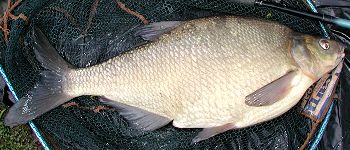Most anglers think they can recognise bream quite easily. The familiar hump-backed shape, the large, bronze-grey flanks and the under-slung mouth are unmistakable characteristics.. or are they? In fact, there are two main species of bream in British waters – the common or bronze bream, and the silver bream – and the fish are capable of hybridising with roach and rudd.

Spot the difference
Few anglers will take the trouble to study a small fish to determine whether its eye diameter is longer than the distance from its mouth to its eye, or to count the 44-48 scales on the lateral line, two characteristics of the silver bream. In contrast, the bronze bream has a smaller eye and 51-60 lateral line scales, and its throat or pharyngeal teeth are different to those of its smaller cousin. I wonder how many record-sized silver bream (the current British record is l5oz) have been returned unwittingly!
Grubbers
The natural food of bream are bottom-dwelling invertebrate animals such as worms and water snails, and the fish can consume large quantities of insect larvae, including chironomid larvae (or ‘bloodworms’). The shape of their mouthes is ideal for sifting through the bottom mud to locate this food, and the accompanying release of bubbles and the colouring-up of the water are often reliable guides to the presence of bream shoals.
Gang culture
Quite why bream form large shoals is open to debate, but this behaviour is probably related to the instinct to survive – to provide ‘safety in numbers’ from predators or to help locate food for all to share. The shoaling instinct remains throughout their lives, even on waters containing very small numbers of specimen-sized bream, and fish of similar sizes often shoal together, Some dustbin lid!
How big bream may grow in Britain is equally unclear, A decade ago, few anglers could have guessed that an 18lb bream would be possible, yet two such fish were caught in 2001. Evidence from Europe suggests that the top weight for the species is somewhat higher, and we may well witness the capture of a bream of 20lb+ at some stage in the near future.
–*–
If you are interested in cheap bream fishing tackle and bait, please click here.




















